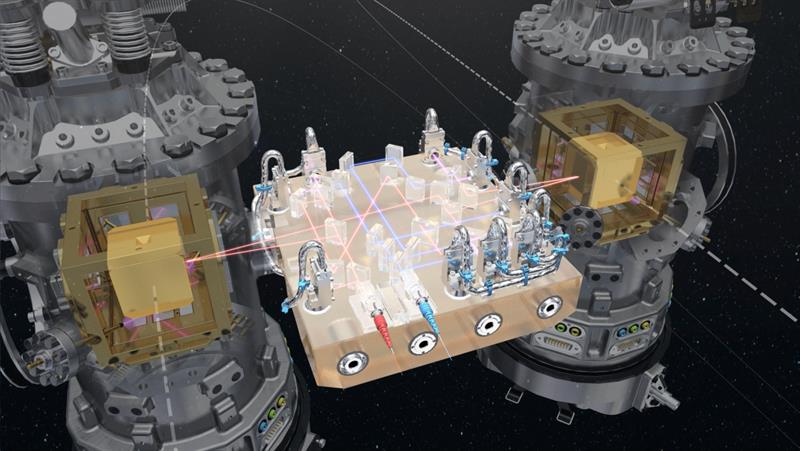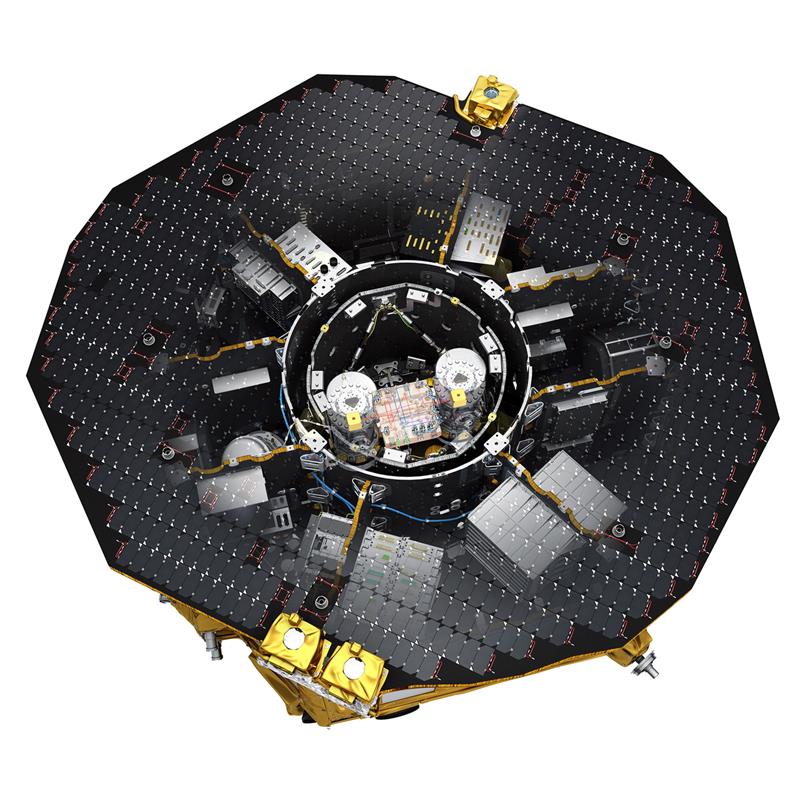That object – a binary pulsar – was then studied for eight years, with the conclusion that the two pulsars were getting closer to each other at exactly the rate predicted by Einstein’s theory. On that basis, the astronomers said, there was ‘no doubt’ gravity waves were being emitted. The problem was detecting them. It wasn’t until September 2015 that scientists detected gravity waves definitively using the Laser Interferometer Gravitational Wave Observatory – LIGO.
But LIGO isn’t the only experiment looking for gravity waves. The European Space Agency (ESA) is planning LISA – the Laser Interferometer Space Antenna.
Because gravitational waves are extremely weak, ESA is looking to detect them from space. According to the project, these low frequency gravitational waves – of the order of mHz – can be ‘blotted out’ on Earth by local noise; even an observatory far from the ocean can be affected by waves hitting the shore.
The first step in this process has been the launch of LISA Pathfinder. Whilst LISA Pathfinder can’t detect gravitational waves, it is being used to test one of the key ideas behind gravitational wave detectors; tracking two free floating test masses. The satellite features several new technologies; one of these isolates the test masses from external forces in space, another enables picoscale measurements to be performed by an onboard interferometer.
 At the heart of LISA Pathfinder is the LISA Technology Package (LTP). This contains two identical test masses – gold and platinum cubes measuring 46mm on each side. Both masses are suspended in their own vacuum container and act not only as mirrors for the interferometer, but also as inertial references for the drag free control system. The LTP also features inertial sensors, interferometric readout, a payload computer and a diagnostic system.
At the heart of LISA Pathfinder is the LISA Technology Package (LTP). This contains two identical test masses – gold and platinum cubes measuring 46mm on each side. Both masses are suspended in their own vacuum container and act not only as mirrors for the interferometer, but also as inertial references for the drag free control system. The LTP also features inertial sensors, interferometric readout, a payload computer and a diagnostic system.
The two test masses float inside the satellite, with a measurement system sensing their motion relative to each other. Normally, the masses should move in synchrony. However, if an external force acts on them, they will move differently and this will be detected.
The spacecraft tracks the test masses using an ultrastable laser interferometer. A laser beam is split in two, bounced off the surfaces of the test masses and then recombined. Changes in the interference signal between the beams will detect a difference in movement between the two as small as 1picometre.
César García Marirrodriga, LISA Pathfinder project manager, said there are two types of position sensors around the test masses. “The first is a set of capacitive sensors; electrodes installed in a hollow cube called the EH. There are two sensors on each of side of the cube. When the test mass approaches or recedes from any side of the EH, the capacitance changes and we can determine the position and the angle of the test mass with respect to the EH within a few nanometres.
“The second position sensor – a heterodyne Mach-Zehnder interferometer – is accurate to picometres, providing information on the change of distance between the test mass and the spacecraft, but only in the X direction.”
 The Mach-Zehnder interferometer uses a laser with a wavelength of 1064nm. Marirrodriga noted: “The light goes through a splitter and then an acousto-optic modulator, which changes the frequency of each of the beams to generate a heterodyne frequency (fhet) of about 1kHz. After travelling different paths – one of them reflecting on the test mass – the two beams interfere at a second beam splitter.
The Mach-Zehnder interferometer uses a laser with a wavelength of 1064nm. Marirrodriga noted: “The light goes through a splitter and then an acousto-optic modulator, which changes the frequency of each of the beams to generate a heterodyne frequency (fhet) of about 1kHz. After travelling different paths – one of them reflecting on the test mass – the two beams interfere at a second beam splitter.
“The resulting photocurrent, measured by a photodiode, contains a strong component at fhet. Any change of distance between the test mass and the spacecraft translates into a phase variation of the heterodyne signal, which is measured electronically with respect to a phase reference derived from an auxiliary interferometer that is not subject to the path length variations.”
LISA Pathfinder features four interferometers. One provides information on the change in distance between test mass 1 and the spacecraft, while another measures the change in distance between the two test masses. The third system provides a reference for the first two systems, while the final system uses the interfering beams from the third system, but has unequal path lengths, allowing fluctuations in laser frequency to be determined.
One of the challenges is to keep the test masses free floating – the gap between the cubes and the EH is about 4mm. Marirrodriga said: “The main external force affecting the spacecraft is solar radiation pressure (around 21µN). But there is also the differential infrared emission of the spacecraft – one side is hotter than the other. This creates a force of around 7µN in the same direction as the solar radiation pressure and the combined force makes the spacecraft approach the free floating test masses.
“Using the position information gained from capacitive sensing, a control system calculates the thrust that needs to be provided by a set of micro Newton cold gas thrusters in order to compensate.”
While LISA Pathfinder makes the measurements, interpretation has to be done back on Earth, with data transmitted using two sets of X band antennas.
Marirrodriga explained: “During normal operations at L1 (the point around 1.5m km from Earth at which the gravitational attraction of the Sun partially cancels that of the Earth), a fixed medium gain antenna provides the necessary up- and downlink. This antenna points some 30° off LISA’s Z-axis. LISA follows a Lissajous orbit around L1, taking around six months to complete, so it rotates around its Z-axis once every period so the Earth is always aligned.”
LISA Pathfinder will be in touch with the Earth for about eight hours a day. The first data to be transmitted each day relates to the health of the spacecraft and the experiment. Following that, scientific data is downloaded for further analysis.
If the technologies perform as expected, the project will move to the next phase; the so called evolved LISA (eLISA). This will use three satellites about 1km apart, each equipped with free falling test masses. However, eLISA isn’t expected to be active until 2034.
The reason for the huge distance is the almost imperceptible effect of a gravitational wave. According to ESA, a low frequency gravitational wave would cause a 1m long bar to move by less than 10-21m. With an interferometer 106m long, the effect of such a wave becomes measurable.
Marirrodriga said the three satellites will be a constellation, rather than a formation. “Their relative positions will be known,” he said, “but not controlled.
“However long the interferometer arm will be, the metrology accuracy will be the same as for LISA Pathfinder – a few picometres in the frequency band of interest (mHz). The suppression of non gravitational forces should be the same as for LISA Pathfinder, so one can say that 90% of the technology needed for eLISA will have been demonstrated through LISA Pathfinder,” he concluded.







